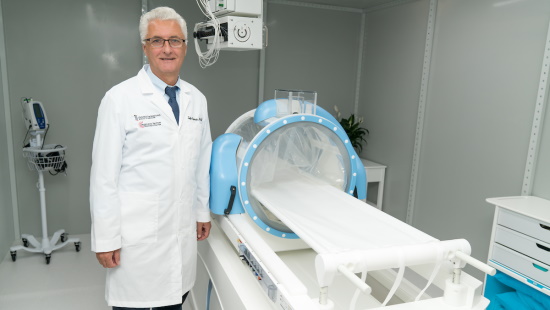TrueBeam
TrueBeam: Latest all-digital technology increases precision and shortens treatment time
Nearly two-thirds of cancer patients receive radiation therapy, either alone or combined with chemotherapy or surgery, as part of their treatment. Traditional radiation therapy is delivered in small daily doses over the course of weeks. Newer stereotactic treatment delivery methods can take much less time, as concentrated high-dose radiation is delivered directly to the tumor with extreme precision.
The latest of these technologies is known as the TrueBeam system and can deliver radiation treatments with sub-millimeter accuracy, in some cases up to 50 percent faster than earlier systems. Experts in the Department of Radiation Oncology at the University of Maryland Greenebaum Comprehensive Cancer Center, who were instrumental in testing the new technology, are using this advanced type of linear accelerator to treat tumors of the lung, breast, prostate, head and neck, spine and other types of cancer.
“With this technology, we can more effectively target cancers that are deep within the body, such as in the liver, pancreas or lung, with high doses of radiation, minimizing the damage to nearby healthy tissue. In some cases, we will be able to reduce the duration and number of treatment sessions from weeks to only a few days, which helps to improve patients’ quality of life,” says Mohan Suntha, MD, University of Maryland Medical System President and CEO.
TrueBeam can deliver a variety of advanced radiation treatments, including image-guided radiotherapy (IGRT), intensity-modulated radiotherapy (IMRT), stereotactic body radiotherapy (SBRT) and RapidArc radiotherapy. It also provides advanced 3-D imaging during treatment and synchronizes the delivery of the radiation beam with the patient’s breathing.
The Department of Radiation Oncology was one of four centers worldwide to test a prototype of the technology, which was developed by Varian Medical Systems. “We were among the first sites to perform extensive testing to benchmark the new machine,” says Warren D’Souza, PhD, associate professor of radiation oncology and chief of medical physics at the School of Medicine. “It’s a new platform that will allow for future development of more advanced radiation delivery techniques, and we performed independent tests to evaluate its capabilities.”
The Department of Radiation Oncology first entered into a master research agreement with Varian to develop new technologies in 2005 and recently renewed the agreement for an additional three years.
“Our physicists provided important input about the performance and capabilities of this new system, which significantly reduces treatment times for patients and enables us to more precisely target difficult-to-reach tumors. In a very real way, we are helping to develop the technologies of tomorrow, and we are extremely pleased to be able to offer this latest advance in radiation technology to our cancer patients,” says William F. Regine, MD, professor and Isadore and Fannie Schneider Foxman chair of radiation oncology at the University of Maryland School of Medicine and chief of radiation oncology at the University of Maryland Greenebaum Comprehensive Cancer Center.
The Department of Radiation Oncology has a long tradition of research and innovation. Physicist Cedric X. Yu, DSc, pioneered the concept of intensity modulated arc therapy (IMAT) in 1995, and later, arc modulated radiotherapy (AMAT), which demonstrated that arcs can be used to deliver intensity modulated radiotherapy. In 2007, Varian developed RapidArc, which similarly delivers radiation to the tumor as the treatment machine moves around the patient in a single continuous 360-degree rotation. Compared with conventional IMRT treatments, which may take up to 15 or 20 minutes, RapidArc treatments take about two minutes. According to Varian, a RapidArc treatment using its new TrueBeam system can be completed in one minute.

